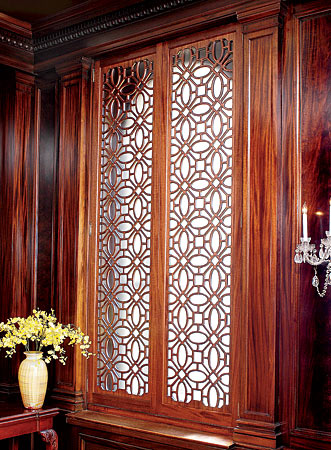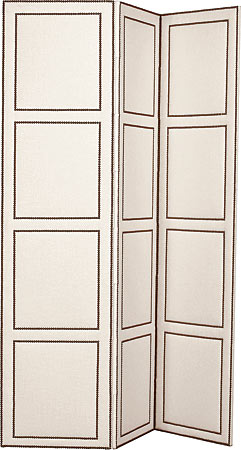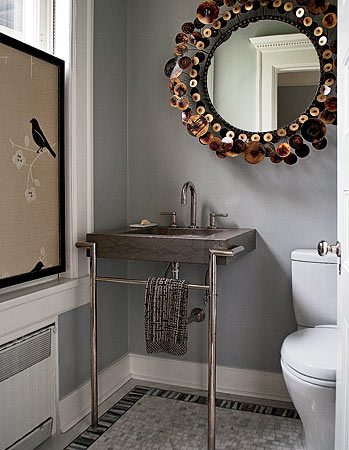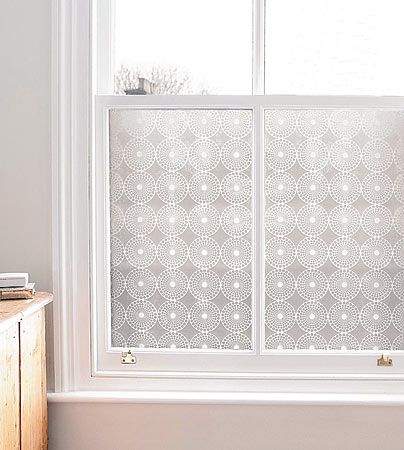Q: I don’t want elaborate fabric window treatments, but I do need privacy. What are my options?
A: Honeycomb (or cellular) blinds are a popular choice, as they come in lots of materials with varying degrees of translucency, and many can be raised from the bottom and/or lowered from the top. But there are other smart alternatives to consider.
For a client who wanted a bit of privacy but didn’t want to sacrifice sunlight, air circulation, or pizzazz, Michele Fitzpatrick of Verde Design installed a gleaming wall-to-wall scrim of metal beads by ShimmerScreen (shimmerscreen.com), made of the same ball chain used for key holders. The chains undulate in the breeze and shield out light, and “you can walk right through them when the patio doors are open,” Fitzpatrick says. They come in many sizes and metallic finishes; the smaller and closer together the beads are, the more sun they block.
Other stylish window treatments that let the light shine through but offer some privacy include everything from films you stick right on the glass to installed panels that swing open (or don’t).
Designer Arden Nelson has used translucent films in a dramatic white Moroccan pattern by British designer Emma Jeffs (2jane.com), attaching them directly to windows in the powder room and laundry room of a home. They come in many patterns, range from about $79 to $115 a roll, and can easily be peeled off when you’re ready to redecorate.
Interior designer Anne Coyle, also a fan of Moroccan patterns, uses lacy fiberboard grilles by Pinecrest as swing-open shutters, painting them vibrant colors to coordinate with other elements in a room. An update on a traditional architectural element, the grilles come in more than 100 patterns and a range of finishes (see Lightsmith Grilles at pinecrestinc.com). Designer Lisa Ewing employs a similar tactic by using translucent panels of sandblasted Plexiglas; she once covered a loft’s 40-foot-wide window with a series of hinged panels that fold out like accordion doors.
Fiberboard grilles and sandblasted acrylic panels can also be fashioned into folding screens that stand on the floor and may be positioned near windows but easily moved when desired. Traditional decorative screens, opaque or not, serve the same purpose. “You can fold them away if you want sunlight, and they’re easy to take with you when you move,” notes Chicago designer Edyta Czajkowska, who has used them in several homes.
But don’t rule out fabric treatments. It’s true, draperies can be expensive if you’re going the custom route, and they also require a certain level of commitment—their fittings and fixtures often necessitate a professional installer and make them tricky to replace or remove. And sometimes they block more natural light and fresh air than you’d like them to. But sheer curtains can work splendidly.
For privacy and light with an ethereal glow, “sheers are always the way to go. They let light filter in, but if you choose them in white or cream, they also amplify it, which gives windows a luminous aura,” explains Ruthie Alan of Alan Design Studio. Interior designer Petra Adelfang, who heads her namesake Glencoe firm, likes Calvin Fabrics’ Mirage Sheer Casement, a superfine, high-tech polyester from Switzerland that looks like fine cotton and comes in a good range of filmy creams and whites (available through designers at Donghia in the Merchandise Mart).
To raise the style quotient of plain sheers, Alan suggests finishing them off with a delicate decorative embellishment at the edges or hem—or both. Options range from tape trims to pouffy little pompons.
In a variation on the theme, designer Lisa Becker covered a 20-foot-high, three-foot- wide window in her soaring two-story entryway with a swath of sheer muslin and installed on a simple rod—then tacked sinewy hemp fishnet over the fabric. It blocks an uninspiring view of a brick wall six feet from the side of her home. “When light shines through, it makes a graphically intriguing pattern,” she says.
Becker found the muslin at Fishman’s Fabrics and scored the netting at the Randolph Street Market. She cut the netting to size and then fastened it to the wall above the sheer. In the tall, pristine white hall, “the raw edges add texture and visual interest,” she says.
A close relative of the sheer is the translucent half-panel treatment Nelson devised for a client “who wanted every bit of light she could get, but the dining room’s windows overlooked the house next door.” Nelson covered the bottom panes of these traditional double-hung windows with creamy linen flat panels that mask the less-than-optimal view from the dining table but allow diffuse light to filter in. Full-strength light comes through the top panes. She used lightweight linen from Fishman’s and installed the panels on tension rods bought at a home design center.
Designer Julie Fleps made a similar move in a client’s Evanston home when she framed a pretty panel of wallpaper and attached it to the powder room window with L-brackets, letting light shine in above it. The beauty of this tactic is its versatility, as other materials—from mirrors to works of art—can also stand in to great effect.
NEXT: Windows of opportunity »
Windows of opportunity

1 Framed Lightsmith Grilles from Pinecrest.

2 An upholstered folding screen with nail-head trim by Victoria Hagan.

3 A framed piece of wallpaper mounted on L-brackets by designer Julie Fleps.

4 Adhesive window film (shown in Pearl) by Emma Jeffs.
Have a design or renovation question? Just drop us a note at chicagohome@chicagomag.com, and we’ll do our best to answer it. Sorry, we cannot take questions by phone or guarantee individual responses. We might already have an answer for you—check out our Expert Advice archive.
Photograph: (framed wallpaper) Bonnie James


